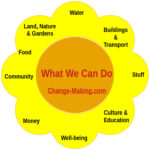Introduction
About “Economic Resilience”
When it comes to change-making, I tend to be the person you’ll find wielding a shovel, either literally or figuratively. Although I spend plenty of time talking in meetings, I feel happiest when I’m out there getting things done. With that shovel in hand, you can really see progress.
I tire quickly of environmental and social change books where 80% of the book convinces you of today’s problems and how bad they are, with only the final skimpy chapter telling you what you might do about it. I’m also tired of books that present theoretical and inaccessible “solutions”—things that have never been tried before, never been achieved before anywhere on the planet. Give me my shovel; I need something tangible to work with.
Economics isn’t necessarily like that.There is plenty of economic change-making that has to take place in meeting rooms and only a limited amount that is tangible and can be attacked with a shovel.But in this booklet I have tried my best to point the way toward the corners where the “shovels” and “pickaxes” are stashed, for those who are eager to get down to work.
A few of these things can be done alone or with a single family. But almost all of them need to be done at a community level, because that’s where ECONOMICS takes place: it all boils down to transactions between people.
Part I of this booklet explains the problems, because we shovel‑wielders really should understand what we are working with in order to begin to solve it.Part II critiques what several economic theorists see as possible routes forward for the “big picture” economy.
But the central question of this booklet is what we can do at the grassroots level. Part III (approximately 70% of the booklet) offers a panorama of concrete and practical examples, ideas, and resources for building local economic resilience. If you’re a really hard-core shovel‑wielder, go ahead and skip to [page reference] and begin there.
Part III begins, not with some utopian fantasy of where we could be in the distant future, but with where we are right now: surrounded by a crumbling economy, saddled with rent to pay and children to feed. What can we do to survive?
The idea of resilience comes from the study of ecology. It’s really about how systems, settlements, withstand shock from the outside … that they don’t just unravel, and fall to pieces. … It’s about building modularity into what we do, building surge breakers into how we organize the basic things that support us.
— Rob Hopkins, 2009 TED talk
Note: The entries in this blog software were not uploaded in order. To read the booklet in order, follow the orange “next section” links at the bottom of each post.


